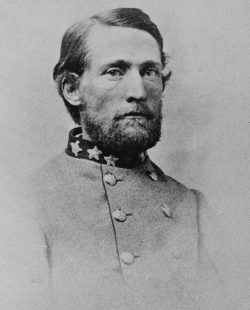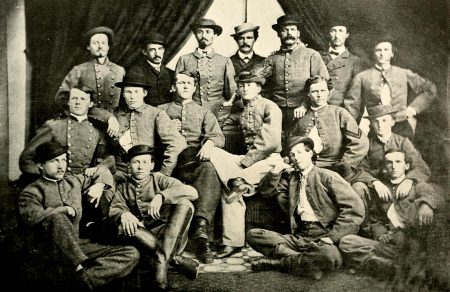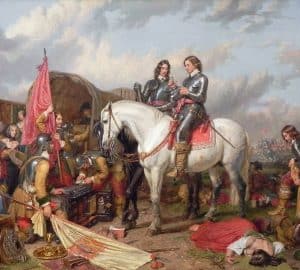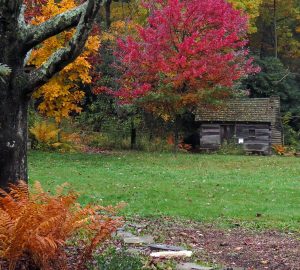Along the banks of the Shenandoah River, in the beautiful Page Valley near Luray, Virginia, a baby boy was born on August 27, 1838. Few could have guessed that this peaceful valley, dotted with farms and filled with lovely vistas, would one day be blackened with smoke and stained with blood. The boy would play an important role in that coming war.
Samuel Forrer Chapman had a happy childhood. He fished the Shenandoah River, explored the nearby caves, and helped his parents on the family farm. His family attended Main Street Baptist Church in Luray, Virginia. As a boy, Sam Chapman was tutored by a pious young man named Jedediah Hotchkiss, famous as the eventual mapmaker of Stonewall Jackson.
At the age of 20, Sam Chapman professed faith in the Lord Jesus Christ and was baptized in the Shenandoah. Soon after his conversion, he began to sense the calling of God upon his life to become a minister of the Gospel. This same year, in 1858, he enrolled in Virginia Baptist Seminary in Richmond with the purpose of preparing himself for the ministry.
Sam’s plans were cut short by the storm of war. Only a few days after the secession of Virginia, Sam went home. He enlisted in the Warren Rifles at Front Royal and, when asked to state his occupation, he wrote “Minister.” The Warren Rifles were part of the Seventeenth Virginia Infantry. They were present at the Battle of Manassas in July of 1861, but saw little action. Sam was disappointed. When Sam’s brother, William, was elected to become captain of an artillery company known as the Dixie Artillery, Sam was asked by his brother to join him. Sam Chapman was given a commission as a lieutenant of artillery and participated in the Seven Days Battles around Richmond.
Finally at the Battle of Second Manassas in August of 1862, Sam Chapman got his real taste of hot combat. He and his artillery were stationed at the “hinge” that joined Jackson’s Second Corps and the First Corps under Longstreet. The well-positioned Confederate artillery inflicted appalling casualties upon the forces of General Pope. Lieutenant Chapman described how his guns tore holes in the long lines of Federal infantry saying, “We could not miss them.”
The Confederate artillery was reorganized in the fall of 1862, and Chapman found himself as an officer without a command. He was sent to round up conscripts and deserters, a distasteful but necessary task. It was during this time that Sam heard about John S. Mosby, a Confederate partisan ranger who was mobilizing resistance behind Union lines and leading daring strikes against Federal supply stations and headquarters.

Sam Chapman met Mosby in the winter of 1862-63 and offered his services. Mosby liked Sam right away – especially after he saw him in battle. Mosby later wrote of Sam Chapman, “His character as a soldier was more on the model of the Hebrew prophets than the apostles. He was generally in front of everybody in a fight.” Mosby went on to say of the man who became known as Mosby’s Fighting Parson, “He was a Baptist minister who prayed through a six-shooter, which he claimed was the most efficacious form of praying . . . when dealing with Yankees.”
In one particularly dangerous action when Mosby’s command surprised and almost captured, Mosby laughed out loud to see Sam Chapman standing in his stirrups beside a narrow gate through which the Union cavalrymen had to pass. Mosby described how the Fighting Parson “had already exhausted every barrel of his two pistols and had drawn his sabre. Sam, to give more vigor to his blows, was standing straight up in his stirrups dealing them right and left.”
While most Confederate troops rested between major campaigns, Mosby’s rangers were always on the move, fighting a sharp skirmish here and raiding a headquarters there. They generally rode horses that they had captured themselves from Yankee pickets. Occasionally, Mosby and his men would capture a piece of artillery. Sam Chapman’s experience in the artillery made him a valuable officer to Mosby.
In May of 1863, Mosby and his rangers were in a hot fight at Greenwich. During this engagement, Sam Chapman was grievously wounded in the upper thigh. Mosby confessed that he and the other rangers viewed their “soldier priest” as invulnerable to bullets, but his moment had come. When last seen by his comrades, the “Fighting Parson” was engaged in hand to hand combat, wielding the sponge staff of his artillery piece when he fell. They presumed the wound was mortal.
But God had other plans for Sam. A kind family who lived in the neighborhood nursed Sam back to health over a period of many weeks. In the family was an eighteen-year-old girl named Eliza Rebecca Elgin, whom Sam called “Miss Beck.” By the time Sam was fully recovered, he was deeply in love with the Godly girl.

During the winter of 1863-64, Sam Chapman served in an artillery battery with the regular army. This was the season when a great revival swept through the Army of Northern Virginia. The young Fighting Parson had the privilege of preaching to his fellow troops on several occasions, and the Spirit of God moved in a mighty way, drawing men to Christ. He wrote to “Miss Beck” of these stirring scenes.
In late winter, Mosby specifically requested that his “military Calvin” be returned to serve with the partisan rangers again. Sam was happy for two reasons. He was back with Mosby, and he was near his beloved! Sam Chapman was promoted to Captain and promoted to husband on the same day, July 28! The very evening of the wedding, he was called out on an emergency raid. Hardly a honeymoon! Colonel Mosby kindly let Sam and Miss Beck spend a few days together after this raid. Captain Chapman led his company with courage and skill through the rest of the war. On one occasion, his men saw him pursue four Yankees into the woods. They heard a salvo of pistol shots and assumed that their captain was dead. But soon the Fighting Parson emerged from the woods leading four riderless horses.
After the war, Sam Chapman became a minister of the Gospel as he had planned. He served faithfully at the Baptist church in Covington, Virginia, nestled in the mountains west of Lexington. Sam and Miss Beck raised eleven children together, and Sam had the joy of baptizing his own children as believers.
The Fighting Parson strapped on his revolver once again in 1898 with the outbreak of the Spanish American War. All who served with him were amazed that they were serving with a former captain in Mosby’s feared Rangers!
Miss Beck died in 1900 of a kidney disease. Sam sat faithfully by her side nursing her just as she had once nursed him. Sam lived on for 19 more years, still preaching whenever and wherever he was able. Sam went to be with his Lord on May 21, 1919, at the age of 81, surrounded by his children and grandchildren.
Drawn from Mosby’s Fighting Parson: the Life and Times of Sam Chapman by Peter Brown




